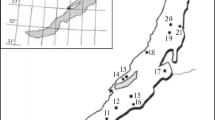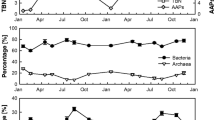Abstract
Vertical distribution of bacteria in Lake Vanda, an Antarctic meromictic lake, was examined by the acridine orange epifluorescence direct count method. Total bacteria were 104–105 cells · ml−1 in the water at 55 m depth and above, and increased drastically to 107 cells · ml−1 in the bottom water. Filamentous or long rodshaped bacteria occurred at a high frequency in the upper layers, but in the bottom layers most bacteria were coccoidal or short rods. Mean bacterial cell volume in water of between 10 m and 60 m deep was fairly large compared with common bacterial populations in seawater and lake water. Aerobic heterotrophic bacteria were recovered from the water of a depth of 30 m and above, and were assumed to belong to Caulobacter. Viable heterotrophic bacteria were not recovered from the high salinity deep water by media prepared with the same deep water. Phototrophic purple non-sulphur bacteria were isolated by enrichment cultures from water at 55 m depth.
Similar content being viewed by others
References
Aizaki, M., A. Otsuki, T. Fukushima, M. Hosomi & K. Muraoka, 1981. Application of Carlson's trophic state index to Japanese lakes and relationships between the index and other parameters. Verh. int. Ver. Limnol. 21: 675–681.
Angino, E. E. & B. Armitage, 1963. A geochemical study of Lakes Bonney and Vanda, Victoria Land, Antarctica. J. Geol. 71: 89–95.
Benoit, R., R. Hatcher & W. Green, 1971. Bacteriological profiles and some chemical characteristics of two permanently frozen Antarctic lakes. In J. Cairns,Jr. (ed.), The Structure and Function of Fresh-Water Microbial Communities. Virginia Polytechnic and State University, Blacksburg: 281–293.
Buchanan, R. E. & N. E. Gibbons (eds), 1974. Bergey's Manual of Determinative Bacteriology, 8th Edn. Williams & Wilkins Co., Baltimore: 153–155.
Cameron, R. E., F. A. Morelli & L. P. Randall, 1972. Aerial, aquatic and soil microbiology of Don Juan Pond, Antarctica. Antarct. J. US 7: 452–458.
Ferguson, R. L. & P. Rublee, 1976. Contribution of bacteria to standing crop of coastal plankton. Limnol. Oceanogr. 21: 141–144.
Fuhrman, J. A., 1981. Influence of method on the apparent size distribution of bacterioplankton cells: epifluorescence microscopy compared to scanning electron microscopy. Mar. Ecol. Prog. Ser. 5: 103–106.
Goldman, C. R., D. T. Mason & J. E. Hobbie, 1967. Two Antarctic desert lakes. Limnol. Oceanogr. 12: 295–310.
Hand, R. M., 1980. Bacterial populations of two saline Antarctic lakes. In P. A. Trudinger & M. R. Walter (eds.), Biogeochemistry of Ancient and Modern Environments. Proc. 4th int. Symp. Envir. Biogeochem. (ISEB): Springer-Verlag, Berlin: 123–129.
Hand, R. M. & H. R. Burton, 1982. Microbial ecology of an Antarctic saline meromictic lake. Hydrobiologia 82: 363–374.
Herbert, R. A., 1974. Isolation and identification of photosynthetic bacteria (Rhodospirillaceae) from Antarctic marine and freshwater sediments. J. appl. Bacteriol. 41: 75–80.
Hiraishi, A. & H. Kitamura, 1984. Distribution of phototrophic purple nonsulfur bacteria in activated sludge systems and other aquatic environments. Bull. jap. Soc. scient. Fish. 50: 1929–1937.
Hobbie, J. E., R. J. Daley & S. Jasper, 1977. Use of Nuclepore filters for counting bacteria by fluorescence microscopy. Appl. envir. Microbiol. 33: 1225–1228.
Hodson, R. E., F. Azam, A. F. Carlucci, J. A. Fuhrman, D. M. Karl & O. Holm-Hansen, 1981. Microbial uptake of dissolved organic matter in McMurdo Sound, Antarctica. Mar. Biol. 61: 89–94.
Kogure, K., U. Simidu & N. Taga, 1979. A tentative direct microscopic method for counting living marine bacteria. Can. J. Microbiol. 25: 415–420.
Kriss, A. E., I. N. Mitskevich, E. P. Rozanova & L. Osnitskaya, 1976. Microbiological investigations of Lake Vanda (Antarctica). Microbiology 45: 917–922. [Translated from Mikrobiologiya 45: 1075–1081].
Matsumoto, G., T. Torii & T. Hanya, 1979. Distribution of organic constituents in lake waters and sediments of the McMurdo Sound region in the Antarctic. In T. Nagata (ed.), Proceedings of the Seminar III on Dry Valley Drilling Project, 1978. Mem. natn. Inst. Polar Res., Spec. Issue 13. National Institute of Polar Research, Tokyo: 103–120.
Matsumoto, G., T. Torii & T. Hanya, 1982. Nutrient matters in saline lakes of McMurdo Oasis in the 1976–77 summer season. Antarct. Rec. 74: 109–118.
Matsumoto, G., T. Torii & T. Hanya, 1984. Vertical distribution of organic constituents in an Antarctic lake: Lake Vanda. Hydrobiologia 111: 119–126.
Meyer, G. H., M. B. Morrow, O. Wyss, T. E. Berg & J. Littlepage, 1962. Antarctica: the microbiology of an unfrozen saline pond. Science 138: 1103–1104.
Mikell, A. T., B. C. Parker & G. M. Simmons, Jr., 1984. Response of an Antarctic lake heterotrophic community to high dissolved oxygen. Appl. envir. Microbiol. 47: 1062–1066.
Pedrós-Alió, C & T. D. Brock, 1982. Assessing biomass and production of bacteria in eutrophic Lake Mendota, Wisconsin. Appl. envir. Microbiol. 44: 203–218.
Siefert, E., R. L. Irgens & N. Pfennig, 1978. Phototrophic purple and green bacteria in a sewage treatment plant. Appl. envir. Microbiol. 35: 38–44.
Sullivan, C. W. & A. C. Palmisano, 1984. Sea ice microbial communities: distribution, abundance, and diversity of ice bacteria in McMurdo Sound, Antarctica, in 1980. Appl. envir. Microbiol. 47: 788–795.
Tezuka, Y., 1979. Distribution of sulfate-reducing bacteria and sulfide in aquatic sediments. Jap. J. Ecol. 29: 95–102.
Torii, T., N. Yamagata, S. Nakaya, S. Murata, T. Hashimoto, O. Matsubaya & H. Sakai, 1975. Geochemical aspects of the McMurdo saline lakes with special emphasis on the distribution of nutrient matters. In T. Torii (ed.), Geochemical and Geophysical Studies of Dry Valleys, Victoria Land in Antarctica. Mem. natn. Inst. Polar Res., Spec. Issue 4. National Institute of Polar Research, Tokyo: 5–29.
Trüper, H. G. & N. Pfennig, 1981. Characterization and identification of the anoxygenic phototrophic bacteria. In M. P. Starr et al. (eds.), The Prokaryotes, 1. Springer-Verlag, Berlin: 299–312.
Vincent, W. F., M. T. Downes & C. L. Vincent, 1981. Nitrous oxide cycling in Lake Vanda, Antarctica. Nature 292: 618–620.
Waguri, O., 1976. Isolation of microorganisms from salt lakes in the Dry Valley, Antarctica, and their living environment. Antarct. Rec. 57: 80–96.
Wakao, N. & C. Furusaka, 1972. A new agar plate method for the quantitative study of sulfate-reducing bacteria in soil. Soil. Sci. Pl. Nutr. 18: 39–44.
Watson, S. W., T. J. Novitsky, H. L. Quinby & F. W. Valois, 1977. Determination of bacterial number and biomass in marine environments. Appl. envir. Microbiol. 33: 940–946.
Wright, S. W. & H. R. Burton, 1981. The biology of Antarctic saline lakes. Hydrobiologia 82: 319–338.
Author information
Authors and Affiliations
Rights and permissions
About this article
Cite this article
Takii, S., Konda, T., Hiraishi, A. et al. Vertical distribution in and isolation of bacteria from Lake Vanda: an Antarctic lake. Hydrobiologia 135, 15–21 (1986). https://doi.org/10.1007/BF00006454
Issue Date:
DOI: https://doi.org/10.1007/BF00006454




